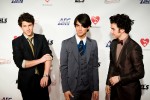America’s burnin’ up with nostalgia. But all fevers have to break.
In March, the Jonas Brothers made a move that possibly changed the course of American society by dropping “Sucker” – their first song since the band’s historic split in 2013. And it didn’t disappoint. Riding a wave of sentimentality, the song clearly drew from Joe and Nick Jonas’ time away from the band, eliciting the upbeat nature of DNCE’s “Toothbrush” and the provocative lyrics of Nick Jonas’ “Chains.” It’s no wonder that their first single since reuniting has led to their first No. 1 song on Billboard.
The brothers’ six-year break allowed them to grow with their audience and evolve, giving the cookie-cutter boy band an opportunity to finally mature. In the music video for “Sucker,” they abandoned the characteristic white skinny jeans and blazers for sleek suits and highlighted their significant others in various extravagant looks. Immediately, the internet erupted, with fans who grew up fawning over the band expressing their obvious excitement over the comeback. And “Cool,” their April follow-up to “Sucker,” has kept the excitement alive, garnering a similar response from former Jonas Brothers fans.
[RELATED: Second Take: Kesha’s new sound is a good balance of poignant and peppy]
Following in the group’s footsteps, Aly & AJ – of “Potential Breakup Song” fame – dropped a single and announced the Sanctuary Tour in March. Their announcement gained more buzz than the fairly under-the-radar music they produced throughout 2017 and 2018.
And now donning blonde bangs, Miley Cyrus recently transformed her hair in a direct callback to her iconic Hannah Montana wig, one she noted herself on her Instagram story. It’s clear the golden age of the Disney Channel is making a comeback. But unlike the Disney renaissance of the ’90s that focused on creating original content, this revival is instead centered on resurrecting what was long thought to be dead – mid-2000s musicians, empowering cartoons and many a girl’s love for Nick Jonas. While they make for fun memories, relying on such content limits creativity and often fails to live up to the original.
One need look only as far as Disney’s multiple live-action remakes to see the dangers of relying too heavily on nostalgia to carry a film. “Beauty and the Beast,” its highest-grossing live-action remake, did fairly well among critics and audiences alike. A few of the company’s live actions have even gone on to earn Oscar nominations in a few categories. But take the upcoming “Aladdin” remake – Will Smith as the Genie almost immediately became a meme, and audiences don’t seem too thrilled with the trailers. Despite its stacked cast, “The Lion King” also has garnered a mixed response because of its categorization as live action despite its reliance on computer-generated imagery. Just because people may have fond memories of specific films doesn’t mean those memories can transfer to remakes.
[RELATED: Second Take: Despite originality concerns, Disney’s CGI remakes excite long-time fans]
But the far-reaching power of nostalgia tends to come with mixed results. The ’90s sitcom “Boy Meets World” was revamped as “Girl Meets World,” which ran from 2014 to 2017. The show took a more progressive stance than its somewhat outdated counterpart, commenting on social justice and feminism, finding its niche among younger Disney Channel viewers. But it didn’t appeal to the same audience that tuned in for “Boy Meets World” week after week, thus failing to pique enough interest to sustain nostalgia-based marketing.
Similarly, “Kim Possible” – the 2019 live-action remake of the beloved Disney cartoon – disappointed even before its February release, with the first trailer earning over three times more dislikes on YouTube than likes. And it arguably fulfilled expectations, earning a 37% audience score on Rotten Tomatoes. Considering that the 2005 animated film “Kim Possible: So the Drama” currently boasts a 73% audience score, it’s evident the reboot was less than successful. Disney both called and beeped, but this audience didn’t want to be reached.
Such content also has an inherent safety net. There’s a built-in fan base; even if people aren’t rewatching “The Lion King” every other week, people might buy a ticket solely to compare the remake to the film from their childhood. And even for audience members, there’s a certain comfort in reimmersing oneself in a world that may have once been so familiar but has since fallen by the wayside. It provides an opportunity to reminisce. At the end of the day, such marketing puts bodies in theaters and money in the bank.
But even with the Jonas Brothers’ recent reintegration to popular culture, it’s unclear thus far if the fever is sustainable or if they will soon fade back into relative obscurity. After all, watching the boys many loved as kids gallivanting around ornate castles and lounging in outdoor bathtubs is entertaining.
But this could very well just be a blip in the internet’s ever-shortening attention span. If the mighty trio of brothers’ next single doesn’t live up to expectations, well, the “Burnin’ Up” music video – complete with its iconic rap solo by Big Rob – is but a click away, ready to ease the wounds of disenchantment.
